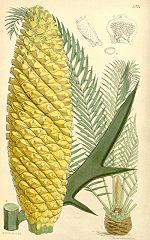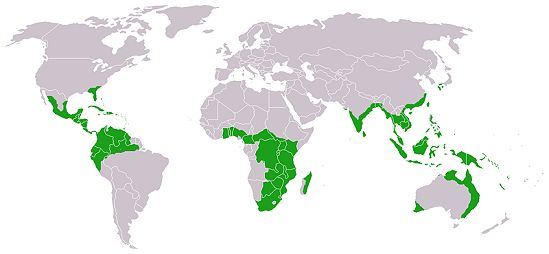South African Cycads
|
Cycad Trivia Encephalartos ghellinckii (Drakensberg cycad) was named for Édouard de Ghellinck de Walle, the 19th- Century Ghent plant collector, horticulturist and amateur botanist who first cultivated it in Europe.  |
||
Cycads date back 280 million years. They have a trunk, leaves and cones,
all of which are covered with stiff, sharp spines. Cycads will either be
male or female in gender and when they are in a reproductive condition
they bear large cones. The regions to which cycads are restricted
probably indicate their former distribution in the Pangea before
the supercontinents Laurasia and Gondwana separated.
 Encephalartos is a genus of cycad native to Africa. Several
species of Encephalartos are commonly referred to as bread trees,
bread palms or 'broodbome', since a bread-like starchy food can be
prepared from the centre of the stem. The genus name is derived from the
Greek words en (within), kephali (head), and artos
(bread), referring to the use of the pith to make food. They are, in
evolutionary terms, some of the most primitive living gymnosperms.
Encephalartos is a genus of cycad native to Africa. Several
species of Encephalartos are commonly referred to as bread trees,
bread palms or 'broodbome', since a bread-like starchy food can be
prepared from the centre of the stem. The genus name is derived from the
Greek words en (within), kephali (head), and artos
(bread), referring to the use of the pith to make food. They are, in
evolutionary terms, some of the most primitive living gymnosperms.
The family Stangeriaceae (named for Dr. William Stanger, 1811-1854), consists of only three extant species, and is thought to be of Gondwanan origin, as fossils have been found in Lower Cretaceous deposits in Argentina, dating to 70-135 million years ago. Stangeria eriopus is a cycad endemic to southern Africa. It is native to the east coast of South Africa and southern Mozambique. It is found within 50 km, but not closer than 2 to 3 km, from the sea. This species of cycad is adaptable and is found in many habitats, from closed forest to grassland. It is the sole species in the genus Stangeria, most closely related to the Australian genus Bowenia, with which it forms the family Stangeriaceae.

 Encephalartos is a genus of cycad native to Africa. Several
species of Encephalartos are commonly referred to as bread trees,
bread palms or 'broodbome', since a bread-like starchy food can be
prepared from the centre of the stem. The genus name is derived from the
Greek words en (within), kephali (head), and artos
(bread), referring to the use of the pith to make food. They are, in
evolutionary terms, some of the most primitive living gymnosperms.
Encephalartos is a genus of cycad native to Africa. Several
species of Encephalartos are commonly referred to as bread trees,
bread palms or 'broodbome', since a bread-like starchy food can be
prepared from the centre of the stem. The genus name is derived from the
Greek words en (within), kephali (head), and artos
(bread), referring to the use of the pith to make food. They are, in
evolutionary terms, some of the most primitive living gymnosperms.The family Stangeriaceae (named for Dr. William Stanger, 1811-1854), consists of only three extant species, and is thought to be of Gondwanan origin, as fossils have been found in Lower Cretaceous deposits in Argentina, dating to 70-135 million years ago. Stangeria eriopus is a cycad endemic to southern Africa. It is native to the east coast of South Africa and southern Mozambique. It is found within 50 km, but not closer than 2 to 3 km, from the sea. This species of cycad is adaptable and is found in many habitats, from closed forest to grassland. It is the sole species in the genus Stangeria, most closely related to the Australian genus Bowenia, with which it forms the family Stangeriaceae.
